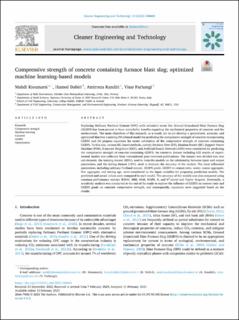Compressive strength of concrete containing furnace blast slag; optimized machine learning-based models
Peer reviewed, Journal article
Published version
Permanent lenke
https://hdl.handle.net/11250/3097408Utgivelsesdato
2023Metadata
Vis full innførselSamlinger
Sammendrag
Replacing Ordinary Portland Cement (OPC) with industrial waste like Ground Granulated Blast Furnace Slag (GGBFS) has been proven to have remarkable benefits regarding the mechanical properties of concrete and the environment. The main objectives of this research, as a result, are to (a) develop a generalized, accurate, and optimized Machine Learning (ML)-based model for predicting the compressive strength of concrete incorporating GGBFS and (b) propose equations for easier calculation of the compressive strength of concrete containing GGBFS. To this aim, various ML-based methods, namely Decision Tree (DT), Random Forest (RF), Support Vector Machine (SVM), K-nearest Neighbors (KNN), and Artificial Neural Network (ANN) were considered for predicting the compressive strength of concrete containing GGBFS. An extensive dataset including 625 results of experimental studies was collected from international peer-reviewed publications. The dataset was divided into two sub-datasets: the training dataset (85%), used to train the models on the relationship between input and output parameters, and the testing dataset (15%), used to evaluate the accuracy of the models. The most influential parameters, including ordinary Portland cement, GGBFS grade, GGBFS to cement ratio, water, coarse aggregate, fine aggregate, and testing age, were considered as the input variables for proposing prediction models. The predicted and actual values were compared in each model. The accuracy of the models was also compared using common performance metrics (RMSE, MSE, MAE, MAPE, R, and R2 -score) and Taylor diagram. Eventually, a sensitivity analysis was conducted at the end of the study to explore the influence of GGBFS on cement ratio and GGBFS grade on concrete compressive strength, and consequently, equations were suggested based on the results.

